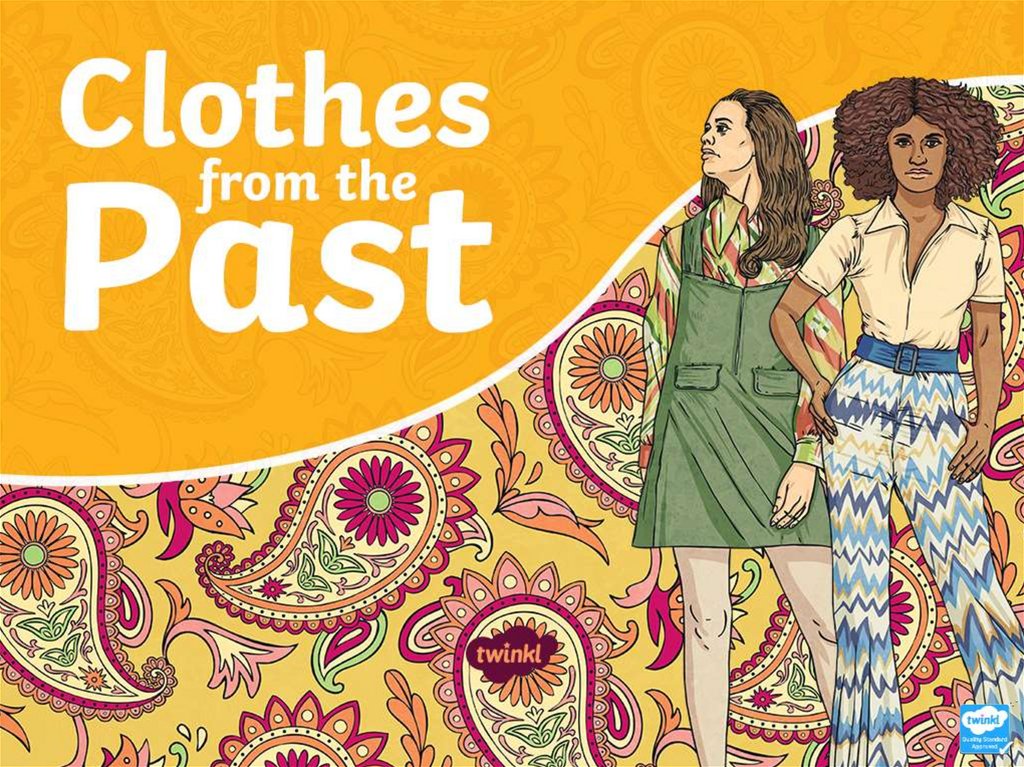Похожие презентации:
Clothes from the past powerpoint
1.
2.
FashionWhat are your favourite things to wear? Why do you like wearing them?
Have your tastes in fashion changed over time? If so, how?
If you think fashion has changed during your lifetime, wait until you
learn about how much it has changed in history.
Let’s take a trip back in time to learn about clothing from the past.
3.
Fashion1990s/2000s
Cargo trousers with pockets down the side were
popular in the 1990s.
The mid 1990s were known as ‘Cool Britannia’.
Pop groups made parka jackets and longer hair
popular. During the 2000s, jeans got skinnier.
Denim was popular with both men and women.
In the late 1990s, jeans were wide at the bottom
and very long; jeans often dragged along the
floor and got very wet on rainy days.
Very low-rise jeans and cropped tops
were in fashion in the early 2000s.
4.
Fashion1980s
White slip-on shoes were popular with men
in the 1980s.
Clothing was bright and often had patterns.
Jeans were stone-washed which made them an
icy-blue with markings on them. Ripped jeans
became popular in the 1980s.
Leggings worn under short floaty skirts were a
popular choice for women.
Leg warmers worn around the ankles were
in fashion.
Jackets with big shoulder pads and
rolled up sleeves were fashionable for
both men and women.
5.
Fashion1970s
Trousers that started off tight but flared from the knee
down (known as flares or bell bottoms) were popular.
Tie dying clothes was fashionable. This was when
string was tied around clothes which were then
dipped in dye, creating swirling patterns.
Other clothing was floaty and bright. The
mini-skirts of the 60s were replaced by
ankle-length ones known as maxi-skirts.
Platform shoes, with large soles and heels
were fashionable.
Floppy hats with wide brims were
popular for women to wear.
6.
Fashion1960s
The big fashion craze of the 60s for women was the
mini-skirt. Many people from older generations were
scandalised by the length of these skirts and dresses!
Towards the end of the decade, hot pants (very
short shorts) were coming in to fashion.
Tights had started being sold in the 1950s and
were becoming more popular. Over-sized bows
and collars on dresses and blouses were popular.
Inspired by groups such as The Beatles, men’s
fashion was still often fairly formal, with suits
and ties being popular.
There were groups known as ‘Rockers’ who
wore jeans, t-shirts and denim jackets.
7.
Fashion1950s
The fashion of the 1950s was still quite formal.
Dresses and skirts came to below the knee, and
were made to stand out by putting lots of
petticoats underneath.
Women frequently wore hats or head scarves
and gloves. Although women didn’t wear trousers
as often as today, slim-fitting knee-length trousers
called capri pants started being worn.
Men often wore suits. On more casual days, they
might wear a pull over instead of a suit jacket, but
still usually wore a tie.
Hats such as homburg hats were still popular. Younger
men started to wear jeans, which had traditionally
been work wear for men who worked in factories.
8.
Fashion1920s
Women’s dresses became shorter and less restrictive
in the 1920s.
Dresses were below the knee and had a drop waist
(where the waist line of the dress fell below the
natural waist line).
Women who followed fashions like the one in this
picture were known as ‘flapper girls’. The hat in
the picture is called a cloche hat and was very
popular in the 20s.
Suits, ties and hats were popular with men. Pin striped
suits were fashionable in the 20s.
Hats including ones called fedoras and homburgs
were also in fashion. Some men wore white
coverings called spats over their shoes.
9.
FashionThe Victorian Era (1837 – 1901)
Wealthy Victorian men wore suits with waistcoats. Bowler hats
and top hats were popular. A pocket watch was often carried.
Rich women wore corsets pulled very tight. Hoops and
petticoats were worn to make skirts stand out. At one
point, bustles were popular. These gave extra shape to
the back of a skirt.
Poor people’s outfits had to be practical and hard-wearing.
Clothes were dark as it was difficult to keep clothes clean in
factories and mines where many poor people worked.
Poor people had to make their shoes last. Many wore
hobnail boots which had nails hammered in to the soles
to make them last longer.
Men and women wore hats or caps. Men took
their hats off inside, women often kept theirs on.
10.
FashionThe Stuart Era (1603 – 1714)
Clothing for the rich during the Stuart era was
very elaborate.
Lace was a popular material for both men and
women, and sleeves were often edged with it.
Many clothes were made from silk brocade,
a very expensive fabric.
Men wore breeches, a type of trouser that
went to just above the knee. Silk stockings
were worn by men and women.
Men and women both wore curled wigs.
Both men and women wore make up.
11.
FashionThe Tudor Era (1485 – 1603)
Tudor men wore outfits called a doublet and hose.
A doublet was a tight fitting jacket worn over the hose
which were short-length trousers worn above the knee,
a bit like modern day shorts.
They wore white silk stockings and hats
decorated with feathers and jewels.
Ruffs (circular collars made of lace and silk) were
worn by men and women. The more fashionable a
person was, the bigger the ruff would be.
Skirts were worn over frames to give the
shape shown in the picture. Clothing was
made of linen, silk and wool.
12.
FashionWhat similarities and differences did you notice? What fashion did you
like the most and why? What fashion did you like the least and why?













 Английский язык
Английский язык








